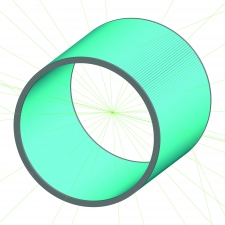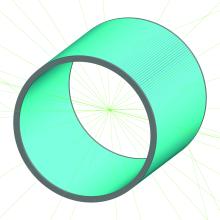NCBJ is taking part in development of J-PET scanner presented within the SciTech Poland exposition organized at the Hannover Messe 2017 fair: we have developed some image reconstruction algorithms. Besides, Świerk supercomputer has simulated operation of detectors employed in the scanner and is used to store/compute the acquired data.
Two systems presented by NCBJ in Hannover included CANIS, a large-size cargo scanner, and SMOC, a mobile industrial radiography device. However, computer scientists and physicists from NCBJ Świerk Computing Centre have also contributed to development of J-PET scanner presented in Hannover by Jagiellonian University in Cracow. Novel plastic detectors employed in the scanner make possible to diagnose patients better and faster. Cracow-based authors of the prototype claim that the scanner is capable to record patient body images at three times as large field of view and twice as large resolution as those offered by traditional (commercially available) solutions. Besides, the scanner under development is much less expensive than PETs traditionally based on scintillating inorganic crystals.
New type detectors needed a dedicated image reconstruction system. The task to develop such as system was accomplished by NCBJ scientists. First of all, the set of detectors used in the scanner was precisely simulated, with all geometrical details taken into account. „The model and the simulations made possible to optimize such detector parameters as shape, situation in respect to radiation origin, sensitivity etc.” – explained Eng. Paweł Kowalski, MSc, from NCBJ. „We were also able to analyse and understand impact of background level and sources of potential interferences with the signal. It was a key factor to obtain maximum clarity and spatial resolution in the ultimately reconstructed images.”
Signals produced by detectors need to be correctly interpreted. „Correct interpretation of data supplied by detectors is probably the most significant element of analyses conducted both in physical experiments and in such systems as PET scanners” – said Professor Wojciech Wiślicki, Director of NCBJ Complex Systems Department and leader of the CIŚ project, who directly managed the works. „Shape of signals produced by J-PET detectors is reconstructed from signal amplitude/leading edge/trailing edge read out by timing modules. Image of the object that has emitted the radiation is finally reconstructed by filtered backward projection from signals produced by the entire collection of detectors. It is the most effective method of reconstructing PET images.”
Other tasks currently accomplished by NCBJ for the J-PET project include measurements and calculations aimed to determine compatibility of the J-PET scanner with NEMA (National Electrical Manufacturers Association) standards. Świerk Computing Centre is also storing/computing data acquired by the scanner prototype.
See the J-PET, CANIS and SMOC presentations on the http://scitechpoland.com/tech-set/ Webpage.







